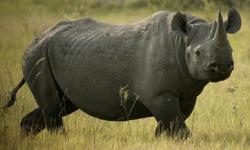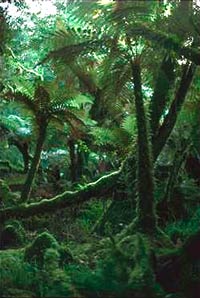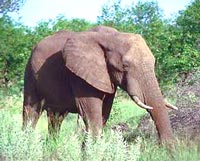Quck answer
The World Wildlife Fund (WWF) is an international organization dedicated to protecting endangered species and their habitats. Founded in 1961, the WWF works in over 100 countries to conserve biodiversity and reduce the impact of human activities on the natural world. The organization focuses on issues such as climate change, deforestation, and the illegal wildlife trade. The WWF also works with local communities to promote sustainable development and conservation efforts. Through partnerships with governments, businesses, and other organizations, the WWF aims to create a world where people and nature thrive together.
Endangered Species

Beverly Joubert/Getty Images
The survival of black rhinos is under threat.
The current state of the environment is gloomy. Air pollution is not only endangering the survival of plants and animals but also affecting human welfare all around the world. The last three decades witnessed millions of acres of forests being burnt, resulting in numerous casualties and colossal financial losses. By 2025, water shortages are predicted to affect up to two-thirds of the world’s population. Every day, the loss of habitat, illegal trade, over-hunting, and economic development continue to destroy wildlife.
Is there anyone out there trying to address these issues and save the world from global disaster? Learn about WWF, also known as “The Conservation Organization,” and how they are working towards keeping the world’s natural resources safe from loss, destruction, and waste.
You can also discover ways to take positive action for the planet.
WWF Background
The World Wildlife Fund for Nature (WWF) is an organization that works towards safeguarding nature and ecological processes. Its mission is “to stop the degradation of the planet’s natural environment and to build a future in which humans live in harmony with nature.” Through policy work, advocacy, grass-roots action, education, and capacity building, WWF aims to:
- conserve the world’s biological diversity
- ensure that the use of renewable natural resources is sustainable
- promote the reduction of pollution and wasteful consumption
How WWF Began
WWF was established after British biologist and first General Director of UNESCO, Sir Julian Huxley, visited East Africa in 1960 and reported on the wildlife conservation situation in the area. Huxley was not satisfied with what he saw and warned that much of the region’s wildlife could disappear within the next 20 years.
- Why are fish on the brink of extinction in 40 years?
- Are frogs facing extinction?
- How do Polar Bears function?
In response to his warning, a group of dedicated experts gathered to establish an organization that would support conservation efforts in early 1961. The group chose Switzerland as the base of operations and decided that a panda would make an excellent logo for the new organization. In September of 1961, the World Wildlife Fund was officially established. WWF raised and donated almost $1.9 million to conservation projects in its first three years. Its first grants went to organizations like the International Union for Conservation of Nature and Natural Resources, the International Council for Bird Preservation (now Birdlife International), the International Waterfowl Research Bureau, and the International Youth Federation for the Study and Conservation of Nature. WWF also made significant early donations to the Charles Darwin Foundation for the GalГЎpagos Islands and Kenya’s Masai Mara Game Reserve.
Natural Facts
- It is estimated that up to 20 percent of the world’s species may disappear in the next three decades.
- More than half of the earth’s original forest cover has been destroyed due to deforestation for timber, fuel, agricultural land, and other basic needs.
- Since 1981, the 10 warmest years recorded in the last 120 years have occurred, and 1998 was the warmest year in history.
- Entanglement kills nearly 60,000 whales, dolphins, and porpoises each year worldwide.
- Over the last 50 years, more than 75,000 chemicals have been developed and introduced into the environment.
Source: WWF
Today’s WWF
Currently, WWF International has 24 affiliates and five associated organizations with primary offices and associates in over 40 countries. The WWF office in Brussels deals with the European Union’s policies and activities, while the WWF office in Washington, D.C. works to influence global institutions involved in international economic issues.
After its first two decades, WWF outgrew its headquarters in Switzerland and moved to Gland in 1979, thanks to an anonymous donation. In 1986, the organization changed its official name from “World Wildlife Fund” to “World Wildlife Fund For Nature,” although the US and Canada still use “World Wildlife Fund.” In 2001, WWF won a legal claim against the World Wrestling Federation (now World Wrestling Entertainment) over use of the initials WWF.
WWF’s Structure
The founders of WWF created National Organizations, separate legal entities accountable to their own boards and donors. They give up to two-thirds of the funds they raise to the international secretariat (at WWF International) and keep the remainder to spend on whichever conservation projects they choose. WWF International is accountable to the National Organizations, donors, and Swiss authorities.
WWF offices are categorized into those that can raise funds and work independently and those that must work under the direction of one of the independent WWF offices. All offices carry out local conservation work such as practical field projects, scientific research, advising governments on environmental policy, promoting environmental education, and raising awareness of environmental issues.
In 1970, the President of WWF International, Prince Bernhard of the Netherlands, set up a fund known as “The 1001: A Nature Trust,” to which 1,001 individuals each contributed $10,000, totaling just over $10 million. Interest from the trust fund helps WWF International meet its administration costs. WWF has collaborated with postal authorities in more than 200 countries to feature select threatened species on official postage stamps since 1983, raising over $13 million. Contributions from individuals remain the organization’s most important source of funds, making up approximately half of its annual income. Governments and aid agencies provide 20 percent of WWF’s income, while 16 percent comes from trusts and legacies and 17 percent comes from other sources, including donations from corporations and royalties on merchandise.
WWF’s Achievements
Throughout its more than 40 years, WWF has significantly contributed to the development and impact of the world conservation movement and sustainable development. Here are a few examples of WWF’s impressive work:

The Project Tiger was initiated in 1973 by the WWF in collaboration with Indira Gandhi to reserve land for nine tiger reserves in India. Later, six more reserves were added in India, three in Nepal, and one in Bangladesh. Nowadays, there are 23 tiger reserves in India that cover around 33,000 square kilometers. Apart from India, the WWF is also working to safeguard Sumatran tigers in Indonesia, Indo-Chinese tigers in Malaysia, Bengal tigers in Nepal, and Siberian tigers in Russia. To learn more about Project Tiger and other global tiger concerns, you can check out the following websites:
- Project Tiger Directorate
- WWF Endangered Species Programme: Tigers
- Sanctuary Asia: Project Tiger
- Wildlife Tours India
- World Wildlife Fund: Tigers

The WWF launched the Tropical Rainforest Campaign in 1975 to raise funds and organize several dozen representative tropical rainforest areas in Central and West Africa, Southeast Asia, and Latin America as national parks or reserves. A second tropical forest campaign was launched in 1982 in Bali (Indonesia), which raised roughly $2.5 million for projects in 11 countries. Forest conservation has been taken seriously as a major habitat issue ever since. To learn more about tropical rainforests, you can check out the following websites:
- WWF Working Locally on the Ground for Forest Conservation
- World Wildlife Fund: Global Forest Program
- RainforestWeb.org
The WWF launched The Seas Must Live in 1976 to establish marine sanctuaries for whales, dolphins, and seals, and protect marine turtle nesting sites. The WWF is currently working worldwide to preserve our seas and marine life by building political will to stop chronic overfishing, decreasing the use of destructive fishing methods, rebuilding devastated fisheries, and enhancing resource management. To find out more about this important issue, click here:
- WWF Saving Our Seas in Asia-Pacific
- World Wildlife Fund’s Ocean Rescue
The Save the Rhino campaign was launched in 1979 by the WWF to combat rhino poaching. Thanks to the WWF’s efforts, the number of rhinoceroses in Kaziranga National Park, India, increased from 400 in 1966 to 1,300 in 1995; in Chitwan Park, Nepal, from 60 in the late 1960s to 600 today; and in southern Africa, from 20 at the turn of the last century to nearly 8,000 today. To learn more about rhinos, you can visit the following websites:
- WWF Endangered Species Programme: Rhinos
- World Wildlife Fund: Saving Rhinos in the Wild
In 1980, the WWF published the World Conservation Strategy, which suggested taking a holistic approach and emphasized the need for natural resource management in a sustainable way. The strategy identified the three main conservation objectives: maintenance of essential ecological processes and life support systems, preservation of genetic diversity, and sustainable use of species and ecosystems. Since its launch, 50 countries have initiated their conservation strategies based on WWF’s recommendations. Click here to find out how you can get a copy of WWF’s strategy series.
The Ivory Trade and Other Efforts

The WWF played a crucial role in bringing about an international moratorium on the ivory trade in 1990.
In 1992, WWF played a role in pressuring governments to sign conventions on climate change and biodiversity at the United Nations Conference on Environment and Development in Rio de Janeiro, which was also known as the Earth Summit. Currently, WWF is focusing its efforts on six global issues that fall into three categories. The three categories include three biomes, the question of species, and two global threats. WWF has established a “Target Driven Programme” (TDP) for each of the six global issues, which recommends strategies such as partnerships, political involvement, or public campaigning. WWF has identified a list of priority ecoregions called the Global 200 Ecoregions, which are the most valuable and vulnerable areas of the world in terms of biodiversity and ecological processes. WWF is conducting conservation efforts on a selected subset of the Global 200 Ecoregions and encourages others to conserve the rest of the Global 200 Ecoregions. If you’re interested in helping save our natural resources, there are a few things you can do, such as learning about the issues, getting involved, and taking action. Check out the links on the next page for more information on WWF and related topics.
Explore How Things Work
Conservation
- How the Nature Conservancy Works
- WWF – The Conservation Organization
- National Wildlife Federation
- U.S. Fish and Wildlife Service
- Natural Resources Conservation Service
- USDA Forest Service
- Environmental Protection Agency (EPA)
- Sierra Club
- Pew Center on Global Climate Change
- Soil and Water Conservation Society
- Endangered Species Update
Natural Phenomena
- How Whales Work
- How Earthquakes Work
- How Fire Works
- How Lightning Works
- How Tornadoes Work
Energy
- How Fuel Cells Work
- How Gasoline Works
- How Hybrid Cars Work
- How Hydropower Plants Work
- How Nuclear Power Works
- How Oil Drilling Works
Climate Change
- Are climate skeptics right?
More Great Links
FAQ
1. What is the World Wildlife Fund?
The World Wildlife Fund (WWF) is an international non-governmental organization that works towards the conservation of nature and protection of endangered species. It was founded in 1961 and operates in more than 100 countries around the world.
2. What are the goals of the WWF?
The main goals of the WWF are to conserve the world’s biological diversity, ensure that the use of renewable natural resources is sustainable, and promote the reduction of pollution and wasteful consumption. The organization also works to raise awareness of environmental issues and encourage action to address them.
3. How does the WWF raise funds?
The WWF raises funds through donations from individuals, corporations, and governments. It also generates revenue from the sale of merchandise, such as t-shirts and stuffed animals, as well as from grants and partnerships with other organizations.
4. What are some of the WWF’s most notable conservation projects?
The WWF has been involved in numerous conservation projects, including efforts to protect endangered species like tigers, elephants, and pandas. The organization has also worked to promote sustainable fishing practices, reduce deforestation, and combat climate change.
5. How does the WWF work with local communities?
The WWF recognizes the importance of working with local communities to achieve its conservation goals. The organization partners with local groups to develop sustainable livelihoods and promote conservation education. It also works with indigenous communities to protect their land rights and preserve traditional knowledge.
6. What is the WWF’s stance on climate change?
The WWF recognizes climate change as one of the biggest threats to the planet’s biodiversity and human well-being. The organization advocates for policies to reduce greenhouse gas emissions and transition to renewable energy sources. It also works to raise awareness of the impacts of climate change and promote sustainable lifestyles.
7. How does the WWF measure its impact?
The WWF uses a range of metrics to measure the impact of its conservation efforts, including the number of hectares of land protected, the number of species saved from extinction, and the reduction in carbon emissions achieved through its initiatives. The organization also conducts regular evaluations of its projects to assess their effectiveness.
8. How can individuals get involved with the WWF?
Individuals can get involved with the WWF by making donations, volunteering their time, and supporting the organization’s campaigns and initiatives. The WWF also offers educational resources, such as lesson plans and toolkits, to help individuals take action on environmental issues.
9. How does the WWF work with businesses?
The WWF works with businesses to promote sustainable practices and reduce their environmental impact. The organization offers certification programs, such as the Forest Stewardship Council and Marine Stewardship Council, to help businesses demonstrate their commitment to sustainability. It also partners with companies to develop sustainable supply chains and reduce waste.
10. How has the WWF’s work impacted the planet?
The WWF’s work has had a significant impact on the planet, including the protection of millions of hectares of land and the conservation of numerous endangered species. The organization has also played a key role in raising awareness of environmental issues and promoting sustainable practices. However, there is still much work to be done to address the threats facing our planet, and the WWF continues to play a critical role in this effort.





Leave a Reply